Barcelona is such a great city with so many beautiful buildings, museums, parks and locations to visit. It can seem rather overwhelming if you only have a few days to spare, and if you’re travelling on a budget. To help, here are my top 10 free things to do in Barcelona.

The climate here means that you can enjoy the outdoor locations all year. The museums and art galleries are also well worth a visit, and have free admission days. These top 10 free things to do in Barcelona are my favorites:
- Visit Parc Güell
- Stroll down Las Ramblas
- Explore the Barrio Gotico
- Visit Montjuic’s Parks
- Experience the Caixa Forum
- Discover the Old Port and Barceloneta
- Relax in Parc de la Ciutadella
- Wander through the Cathedral
- Take advantage of museum free open days
- Saunter along Passeig de Gracia
- Enter the Catalan Parliament
1. Visit Parc Güell
Parc Güell has to be on everyone’s list when visiting Barcelona. Since writing this article there is now a charge to enter the very central area of Parc Güell. However, you can still access most of the park for free and view the restricted areas from a short distance. The park is situated just outside of the main city centre, high on a hill above Gràcia overlooking Barcelona. It was designed by Antoni Gaudí, originally as a residential area enclosed in a park. Parc Güell is a place you can visit again and again. It’s always a joy.
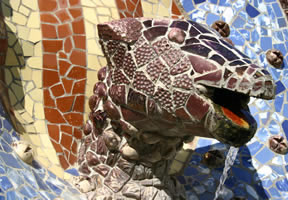
Built on the side of a hill it includes several houses, wonderful structures and mosaic designs. To reach the park you can take Line 3 (green line) of the metro to either Lesseps or Vallcarca. Then there is a 10 – 15 minute uphill walk to the park itself. It’s signposted from both metro stops, but just follow the trail of people usually headed in the same direction. Buses also stop on Travessera de Dalt, and again there’s an uphill walk from the bus stops. The Tourist Bus includes Parc Güell on one of its routes. If you don’t want to walk up the hill, the only option is a taxi.
You can spend hours here wandering along the many paths, enjoying the views and the architecture. One of the houses was lived in by Antoni Gaudi himself for several years. It’s open to the public for a fee. It’s interesting to see the inside and all the furniture he designed specially for the house. Some of the famous structures included in the park are the mosaic salamander at the entrance, the main terrace supported by pillars, surrounded at the top by an undulating mosaic bench, and colonnaded walkways through the park.
There are two cafés in the park, one at the bottom entrance and one towards the top. There’s also a souvenir shop at the lower entrance.
2. Stroll down Las Ramblas
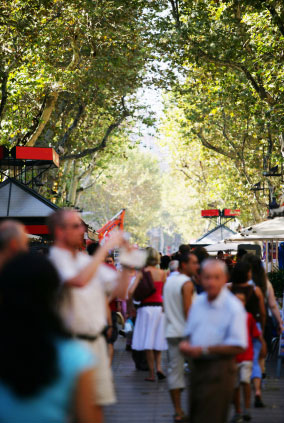
Las Ramblas is the famous boulevard running from the port to Plaza Cataluña. It’s just over a kilometre long and lined with plane trees. In fact, it’s made up of several ‘Ramblas’ hence its plural name. Each Rambla has a different theme and name, and this is reflected in the stalls. There’s the artists’ section, the flower stalls’ section, etc, and along part of La Rambla there are the human statues. The statues are extremely creative and you can stop, enjoy the spectacle and take a photo. Las Ramblas is always busy, even in winter, and it’s a great place to stroll along, enjoy the sun, check out the arts and crafts, and check out some the famous and historical places dotted along the way.
Mid-way along Las Ramblas is the Grand Opera House of Barcelona, the Gran Teatre del Liceu. It’s a beautiful building, and if you do want to spend a bit of money, you can take a tour of the main theatre and some its famous salons. The souvenir shop is free to enter.
Opposite the Liceu is Café de l’Opera, the perfect place to stop for a sandwich or coffee. There are seats on the terrace directly on Las Ramblas, or inside where you can enjoy a typically Catalan atmosphere. The upstairs room has great views of Las Ramblas below.
Shortly after the Liceu, walking towards Plaça Catalunya, you can experience the marvels of La Boqueria. This is the fantastic food market, also known as Mercat de Sant Josep. It’s a vast, bustling market with architectural displays of fruit and vegetables, a diverse fish section as well as bars and restaurants where the food is good.
At the bottom of Las Ramblas, beside the port, is the monument to Christopher Columbus. Here the boulevard has been extended to reach out over the sea on a wooden walkway all the way to Mare Magnum. This section is called La Rambla del Mar.
When you take a stroll along Las Ramblas remember to watch out for pickpockets. Also keep in mind that if you stop for something to eat or drink on any of the terraces along the way you’ll pay top dollar. There are three metro stops on Las Ramblas. Drassanes which is situated at the bottom close to the port and is on Line 3 (the green line). One in the middle called Liceu (also on Line 3). Finally one at the top end called Plaza Cataluña which is on both Line 1 (red) and Line 3 (green).
3. Explore the Barrio Gotico
The Gothic Quarter or Barrio Gótico (Barri Gòtic in Catalan) is the oldest part of Barcelona and is situated to the right of Las Ramblas (looking to the hills). It’s a maze of narrow ancient streets, wonderful buildings, tiny shops, bars and hidden restaurants. As you wander through the alleys you will come across small squares that often have market stalls selling crafts and foods.
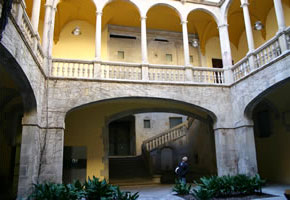
Plaça Reial is one of the largest squares and is just a step from the lower part of Las Ramblas. It’s a great location for eating al fresco and for its bars and clubs of a night-time. Plaza Sant Jaume is another square not to miss, it houses the impressive buildings of the Ajuntament de Barcelona and Palau de la Generalitat.
There are several beautiful churches in the Old Town, which are free to enter if you come across them when open. Santa Maria del Pi is not to be missed, located in Plaça del Pi. There are often artists and market fairs in this square. The church is dominated by its large circular window. The Basílica de Santa Maria del Mar, dating from 14th century, is one of the most important Gothic buildings in Barcelona. This church is located in the El Born area.
Some of the most beautiful buildings are in Plaça del Rei – the Chapel of Santa Agatha is a Gothic chapel built in the 14th century, Palau Reial Major dates from Roman times and the Palau de Lloctinent dates from 16th century.
Exploring the Gothic Quarter is a wonderful experience, and in summer its narrow streets are a shaded refuge from the hot sun.
4. Visit Montjuic’s Parks

Montjuïc is the large hill just to the south that overlooks Barcelona. You can easily spend a day exploring Montjuïc and its many gardens, parks, buildings, galleries and museums. It’s possible to reach Montjuïc by cable car from the Old Port, by bus or by metro from the Parallel stop on Line 3 (green line). There is a small cog railway from Parallel that goes up to Montjuïc.
However, one of the best ways to approach Montjuic is on foot from Plaça Espanya. It’s a grand entrance from here passing between the huge Venetian towers. Walk up Avinguda de la Reina Maria Cristina towards the National Palace, the Palace of Alfonso XIII and the Palace of Victòria Eugènia. This is the area of the magic fountains, which are on display in the evenings during the summer. There are escalators to help you walk up the hill if you don’t want to take all the steps up the hill.
There are many different gardens on Montjuïc: Jardins de Laribal, Jardins del Teatre Grec, Jardins de Mossèn Cinto Verdaguer, one of my favourites is the cactus garden that faces to the sea called Jardins de Mossèn Costa i Llobera. Several museums are also situated here: the Museum of Popular Arts and Industries, the Ethnological Museum, the Archaeological Museum, the Catalan Art Museum and the Joan Miró Foundation (entrance fees apply for the museums – the gardens are free). You can also take a look at one of the stadiums built for the olympics – Estadi Olimpic.
The Castell de Montjuïc dates from the 17th century and is situated at the summit, towards the sea side of Montjuïc. Montjuïc also includes the Spanish village – Poble Espanyol which contains buildings of different architectural styles. The Olympic communications tower (Torre Telefónica) was designed by Santiago Calatrava. It’s an easy walk back down from Montjuïc, through Poble Sec and back to the city.
5. Experience the Caixa Forum
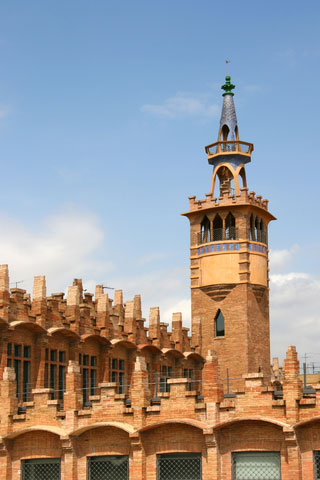
It’s free to enter the Caixa Forum building and visit the permanent exhibition about the building itself. It’s also free to enter the café and book and gift shop. The Caixa Forum is close to Montjuic, housed in a beautiful building that used to be a textile factory and which was designed by Catalan architect Josep Puig i Cadafalch.
The building was originally called the Casaramona factory after its owner and was finished in 1911. The building and art gallery are owned and managed by the bank La Caixa. There are permanent and visiting exhibitions. The permanent exhibition also includes details about its architect Josep Puig i Cadafalch as well as other contemporary artists of the Art Nouveau style.
Guided tours are available, and there is a great café bar and terrace where you can enjoy lunch, a drink, or coffee and cakes.
You can find the gallery on Avinguda Marquès de Comillas 6-8 and reach it via metro at Plaça Espanya. There are many bus lines that stop in Plaça Espanya, with just a short walk to the gallery from there. The Catalan railway lines (Ferrocarrill) also stop in Plaça Espanya: S3, S33, S4, R5 and R6.
For further information, check out the website: caixaforum.es/es/barcelona/home
6. Discover the Old Port and Barceloneta
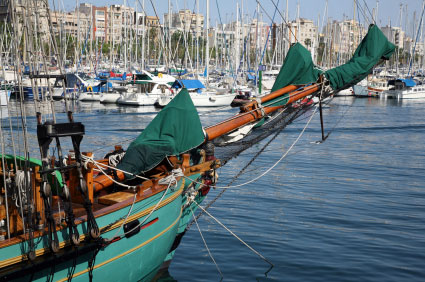
One of the best areas in Barcelona to explore – with the old port, boats, the Mare Magnum shops and restaurants, Barceloneta with its traditional narrow streets and seafood restaurants, and finally the beach.
From the bottom of Las Ramblas you can stroll over the large wooden footbridge that takes you to the end of Moll Espanya. The bridge gives great views of the old port and Barcelona. Mare Magnum is a complex of shops and restaurants looking out onto the port and the World Trade Centre opposite. Moll Espanya also houses the aquarium and the Imax cinema. From here you can continue your walk around Moll Espanya coming out at the bottom of Via Laietana and the start of Barceloneta.

Barceloneta was traditionally the area where Barcelona’s fishermen and their families lived. It still has a close relationship with the fishing industry reflected in the many fish and seafood restaurants there. The front of Barceloneta faces overlooks the old port, this main street is called Passeig de Joan de Borbó and is lined with restaurants. Step from here into Barceloneta’s narrow streets and you will find more small restaurants (with a cheaper menu).
Walking along to the end of Passeig de Joan de Borbó, or cutting through the narrow streets to the other side of Barceloneta brings you out to the Beach. A stroll from here to Port Olímpic is fantastic on a sunny day. There is an esplanade the whole way with chiringitos (beach bars), busy with people enjoying the seaside. On reaching Port Olímpic you can sit down for a meal or a snack in one of the many restaurants lining the port or catch the metro back to Barceloneta.
7. Relax in Parc de la Ciutadella

Parc de la Ciutadella is one of the few green spaces in Barcelona, it’s open from 10am until dusk and there are entrances from Passeig de Pujades and Passeig de Picasso. The park covers a large area (31 ha), and includes the zoo, the Parliament buildings and the Natural Science Museum among other museums. There is also a lake where you can hire a rowing boat. One of the most impressive buildings in the park is the Castel dels Tres Dragons which is now the home of the Museo de Zoologia (Museum of Zoology) and was built in the late 1900s. The large Baroque fountain and water feature is called La Cascada and it was built for an exhibition in 1888.
There are numerous plant and tree identifying name signs throughout the park for those people interested in botany. The park is also home to the largest colony of grey herons in Catalonia. There are picnic areas, a children’s cycle park, play areas as well as bars and toilets.
Every year in the park between June and September there is a jazz programme. The tourist information centre in Plaça Catalunya will have details. It’s a great event where you can relax in the park on a warm summer evening listening to jazz. Starts at 10pm on Wednesdays in July and Wednesdays and Fridays in August.
8. Wander through the Cathedral
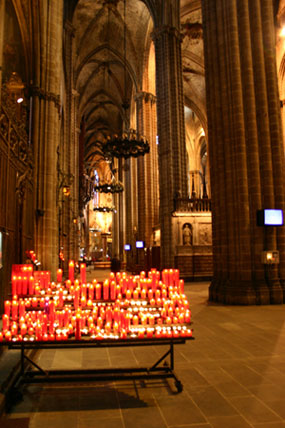
Barcelona’s Gothic cathedral is in the Barrio Gotico and its official name is Cathedral de la Santa Creu i Santa Eulalia, it is also referred to as La Seu. The cathedral is dedicated to St Eulalia – the patron saint of Barcelona. There are records of a religious building on this site as far back as 925 but the building for the current cathedral began in 1298. Parts where not finished until 1913. It’s an impressive building and one of my favourites, with large bell towers, Gothic arches and a carved wooden choir.
It’s an imposing building, just by its sheer size. Take the lift up to the roof to get great views of the gothic quarter and the sea. The cloister, which always contains 13 geese, is a beautiful part of the cathedral. It contains a garden of orange, magnolia and palm trees, fountains and a pond.
There are certain hours of the day when you can enter the cathedral for free: Mon – Fri: 08.00 to 12.45 and 17.15 to 19.30, at other times there is a charge. Nearest metro stations are Liceu and Jaume I.
The cathedral is one of my favourite free things to do in Barcelona, and probably the one I’ve visited most often.
9. Take advantage of museum free open days
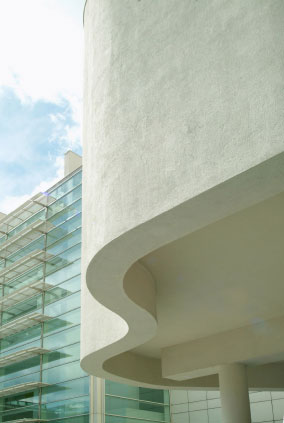
On the first Sunday of every month many museums and art galleries open for free. They include the Picasso Museum –www.museupicasso.bcn.es; the Museu d’Història de Catalunya –www.en.mhcat.net; MNAC (Museu Nacional d’Art de Catalunya) –www.museunacional.cat; and the Natural History Museum (Museu de Ciències Naturals de Barcelona) – www.bcn.es/museuciencies. The Natural History Museum is also open free on Sunday afternoons from 5th April 2009.
The Maritime Museum (Museu Marítim) – www.mmb.cat – has free entrance on the first Saturday of every month after 3pm as long as that Saturday is not a public holiday. The MACBA (Museu d’Art Contemporani de Barcelona) – www.macba.es – has free entry for exhibitions on their first day of opening.
These free days tend to be extremely popular, so you’re advised to get to the museum of your choice as early as possible as there are often queues prior to opening. I’ve listed the websites of the museums as they often open free on other days which will be published on their websites, so it’s worth checking.
Palau Robert – www.gencat.cat/palaurobert – is a small gallery at the top of Passeig de Gracia which is always free and has very interesting exhibitions. Behind the gallery is a charming shady garden and if you walk through the garden back towards Calle Rosselló you will come upon an elegant hotel terrace where you can enjoy a drink.
10. Saunter along Passeig de Gràcia
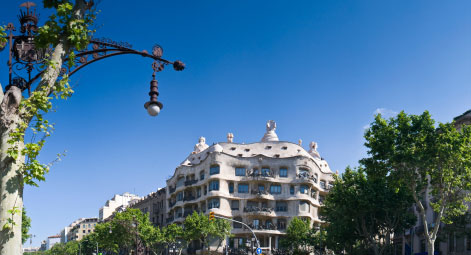
Passeig de Gràcia is Barcelona’s most elegant boulevard and runs from Plaza Cataluña up to Avinguda Diagonal forming the centre of the Eixample district. It’s a wide tree-lined street of beautiful buildings, decorative iron street lamps, designer shops and smart restaurants. Two of Gaudí’s most famous buildings adorn Passeig de Gràcia – Casa Milà (La Pedrera) and Casa Batlló. Casa Amatller by Josep Puig i Cadafalch and Casa Lleó Morera by Lluís Domènech i Montaner are also very beautiful buildings worth noting.
Starting in Plaça Catalunya there is the Tourist Information Centre where you can pick up your maps of Barcelona and any other information about the city. This street is a designer shopper’s paradise; you’ll find most of the top designer labels in Passeig de Gràcia, including Chanel, Armani, Jimmy Choo, Gucci, Yves Saint Laurent, Lacoste and Cartier, to name but a few.
This is a grand street and easily rivals other famous avenues around the world, a stroll along Passeig de Gracia is not to be missed.
11. Visit the Catalan Parliament
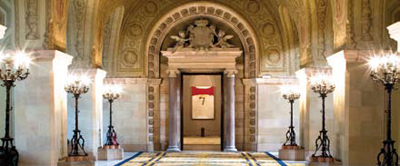
Finally, the last free thing to do in Barcelona – the Parliament of Catalonia. The Parliament building is in the Parc de la Ciutadella and is one of the oldest parliament buildings in the world dating from 1714. Every weekend and holidays the building is open to the public and it’s free to enter. You can visit the Salón de Sesiones, Las salas de comisiones, the offices of the president and the staircase of honour.
Opening hours: Saturday: 10am – 7pm. Sundays and holidays: 10am – 2pm.
Closed 1 January, 1 May, whole of August, 25 & 26 December.

